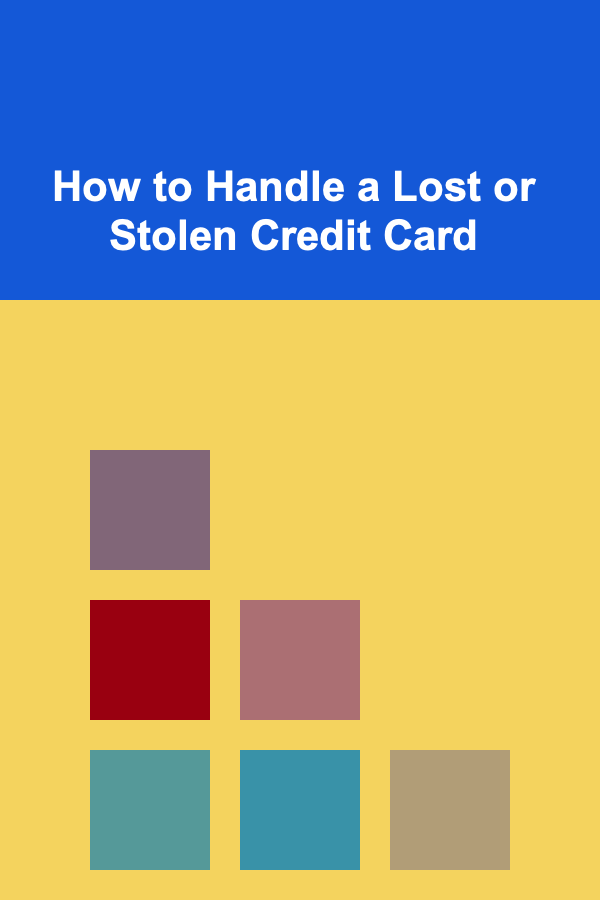
How to Handle a Lost or Stolen Credit Card
ebook include PDF & Audio bundle (Micro Guide)
$12.99$6.99
Limited Time Offer! Order within the next:

Losing your credit card or discovering that it has been stolen can be an incredibly stressful and unsettling experience. With the increasing prevalence of digital transactions, online shopping, and other forms of cashless payments, your credit card is a critical component of your daily life. It provides you with financial flexibility, the ability to make purchases, and in some cases, even access to rewards or points. However, it also puts you at risk if it falls into the wrong hands.
This comprehensive guide aims to provide you with a clear, step-by-step process on what to do if you lose your credit card or suspect that it has been stolen. We will explore both immediate actions you need to take and proactive steps to protect your finances from further damage. By following the outlined strategies, you can minimize the impact of a lost or stolen credit card and safeguard yourself from potential fraud.
Immediate Actions to Take When You Lose Your Credit Card
The first thing to do when you realize that your credit card is missing is to act quickly. The longer your card is unaccounted for, the more likely it is that someone will use it fraudulently. Here are the immediate steps you should take:
1.1. Contact Your Credit Card Issuer
As soon as you notice that your credit card is lost or stolen, the first thing you should do is contact your credit card issuer or bank. They are the ones who can take action to prevent further unauthorized transactions.
- Call the Customer Service Number: The phone number for lost or stolen cards is usually found on the back of your credit card or on the bank's website. Most financial institutions have a 24/7 helpline dedicated to handling lost or stolen cards.
- Report the Loss: Let the customer service representative know that your card has been lost or stolen. Be prepared to verify your identity with personal information such as your name, address, and possibly your social security number.
- Request a Card Block: The representative will block your card to prevent any unauthorized transactions from occurring. They will also ask you to confirm whether any transactions have already been made that you did not authorize.
1.2. Review Your Transactions
Once you report the loss, your bank or card issuer will typically freeze your account to prevent further charges. However, it's crucial to go over your recent transactions and identify if any fraudulent activity has already occurred.
- Go Through Recent Transactions: Check your credit card statements or use your online banking app to review recent transactions. Look for any charges that were not made by you. Fraudulent charges often occur soon after a card is lost or stolen.
- Notify Your Bank of Fraudulent Transactions: If you notice any unauthorized transactions, immediately report them to your bank or credit card issuer. Most companies will offer fraud protection and will likely reverse these charges.
1.3. Request a Replacement Card
Once your card has been blocked, ask your card issuer to send you a new credit card. This will have a new number and security code, ensuring that the lost or stolen card cannot be used.
- New PIN: If you also had a PIN for your credit card, request that a new one be issued to prevent anyone from accessing your account.
- Update Your Payment Information: Once you receive your new card, remember to update your payment details wherever you've used the old card (e.g., online shopping accounts, subscriptions).
1.4. Monitor Your Credit Reports
It's also a good idea to monitor your credit report after the incident. You can request a free credit report from one of the three major credit bureaus (Equifax, Experian, and TransUnion) to check for any suspicious activity.
- Fraud Alerts: You can place a fraud alert on your credit report. This will notify lenders to take extra steps to verify your identity before extending credit in your name, adding an extra layer of protection.
Understanding Your Liability
One of the most important concerns when your credit card is lost or stolen is your potential financial liability. Credit card companies offer varying degrees of protection against fraud, but understanding your rights and responsibilities is essential.
2.1. Federal Protection Under the Fair Credit Billing Act (FCBA)
In the United States, the Fair Credit Billing Act (FCBA) provides protections for credit cardholders in cases of lost or stolen cards.
- Zero Liability: Under the FCBA, your liability for unauthorized charges is limited to $50. However, most credit card issuers offer a zero-liability policy, which means you won't be responsible for any unauthorized charges if you report the card loss promptly.
- Time Limits: To take full advantage of this protection, you need to report the loss as soon as possible. If you report the card as lost or stolen before any unauthorized charges are made, you won't be liable for anything. However, if you wait too long, your liability could increase.
2.2. Credit Card Issuer's Fraud Protection Policies
Most major credit card companies, including Visa, MasterCard, American Express, and Discover, offer comprehensive fraud protection policies, often going beyond the FCBA.
- No Liability for Fraudulent Charges: Many issuers provide zero liability on fraudulent transactions, meaning that you are not held accountable for any charges made after your card was stolen.
- Reversal of Charges: Once you report fraudulent charges, the credit card issuer typically investigates the situation and will reverse the unauthorized charges. However, this process can take time, so it's essential to stay on top of communication with your bank.
2.3. Credit Monitoring and Fraud Alerts
If your credit card has been stolen, it's wise to consider additional steps to protect your identity:
- Fraud Alerts: You can place a fraud alert on your credit report to warn creditors to take extra precautions before opening new accounts in your name. This is typically free and lasts for a year.
- Credit Freeze: A more secure option is a credit freeze, which restricts access to your credit report. This can prevent anyone from opening a new credit account in your name.
- Credit Monitoring Services: Some credit card issuers offer credit monitoring services as part of their fraud protection plans. This can be beneficial for keeping an eye on your credit activity.
Handling Stolen Credit Cards Abroad
If your credit card is stolen while you are abroad, the steps you need to take will be similar to those if you were at home. However, there are a few additional considerations for international situations.
3.1. International Contact Numbers
When traveling abroad, it's important to have access to your credit card issuer's international contact number. Most credit card companies provide a toll-free number for reporting lost or stolen cards from anywhere in the world.
- Call Collect: If you do not have access to a local phone, you can usually call your credit card issuer collect, meaning they will cover the cost of the call.
3.2. Temporary Emergency Card
If you are overseas and unable to use your primary credit card, many card issuers can issue a temporary emergency card or arrange for emergency funds to be sent to you.
- Emergency Funds: Some credit card companies will send a temporary card with a small credit limit to help you until a new card is sent to your location.
3.3. Local Authorities
In some cases, it may be necessary to file a police report for a stolen card if the theft happened while you were abroad. This can help in cases where you need documentation for insurance purposes or to prove the theft when reporting it to your card issuer.
Preventing Future Credit Card Theft
While losing your credit card can be distressing, it also serves as an opportunity to learn how to protect yourself in the future. Here are some preventive steps to minimize the risk of future theft:
4.1. Use Digital Wallets and Two-Factor Authentication
- Digital Wallets: Instead of carrying physical credit cards, consider using digital wallets like Apple Pay, Google Pay, or Samsung Pay. These services use tokenization to keep your card information secure and often provide additional layers of protection.
- Two-Factor Authentication: For online purchases, use two-factor authentication (2FA) to add an extra layer of security. This typically involves verifying your identity via an SMS code, email, or biometric check.
4.2. Secure Your Personal Information
Avoid storing your credit card details in insecure places. When shopping online, ensure that the website uses encryption (look for "https" in the URL), and avoid saving your card details on untrusted sites.
4.3. Use Strong Passwords and Monitor Your Accounts Regularly
Using strong passwords for your online banking and shopping accounts and monitoring your accounts regularly can help you quickly spot any suspicious activity.
4.4. Keep Track of Your Credit Cards
Whenever possible, avoid carrying more than one credit card at a time, and always keep your cards in a safe, secure location. Consider using a credit card holder or wallet that protects against RFID theft, which can occur through scanners used by thieves to read your card's information.
Conclusion
Losing a credit card or having it stolen can be a stressful experience, but knowing how to handle the situation promptly and effectively can significantly minimize the damage. By reporting the loss quickly, reviewing your transactions, understanding your liability protections, and taking steps to prevent future theft, you can safeguard your financial security.
Remember, proactive measures such as using digital wallets, setting fraud alerts, and monitoring your credit can prevent many common problems related to credit card theft. While it's impossible to completely eliminate the risk, being vigilant and taking immediate action if your card is lost or stolen can help you navigate the situation with greater ease and confidence.

How to Maximize Storage in Your Pantry with Space-Saving Tips
Read More
How to Set Conference Goals and Objectives: An Actionable Checklist
Read More
How to Use Your Skills as a Retired Nurse to Create a Profitable Side Hustle
Read More
How to Understand Weight Loss Surgery Options
Read More
How To Master YouTube Marketing for Your POD Designs
Read More
10 Tips for Effective Code Documentation
Read MoreOther Products

How to Maximize Storage in Your Pantry with Space-Saving Tips
Read More
How to Set Conference Goals and Objectives: An Actionable Checklist
Read More
How to Use Your Skills as a Retired Nurse to Create a Profitable Side Hustle
Read More
How to Understand Weight Loss Surgery Options
Read More
How To Master YouTube Marketing for Your POD Designs
Read More